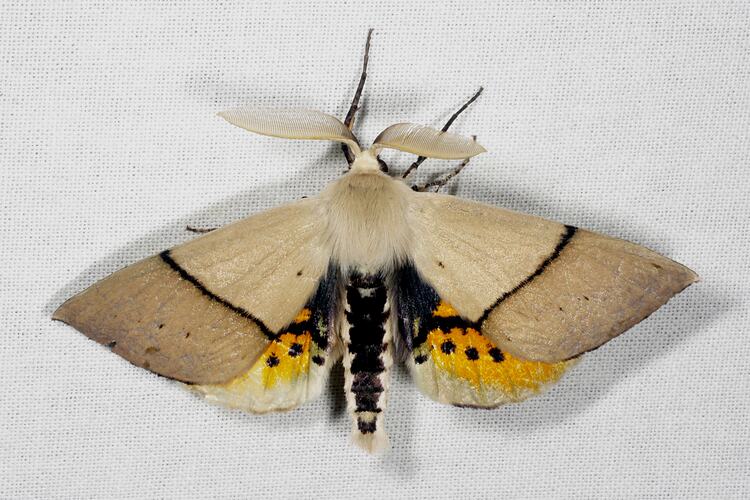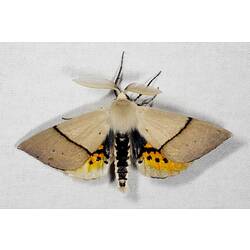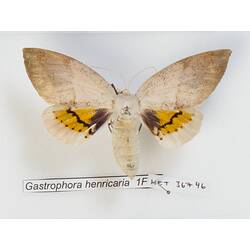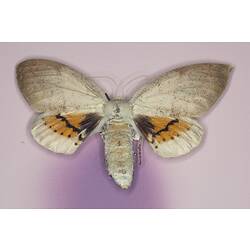General Description
Males; forewings cream with distinctive transverse line, often with three or four small black spots on each wing, underside with a large orange and purplish-black patch. Hindwings orange-yellow with black spots. Thorax black on top, cream underneath. Head cream. Antennae wide and bipectinate. Body length to 25 mm, wingspan to 60 mm. Females; Forewings cream and speckled with dark spots, transverse line less defined than in males and spot on the underside visible through the wing. Hindwings orange and black, similar to males but with distinctive cream border. Thorax cream on top as well as underneath and wider than in males. Antennae almost thread-like. Body length to 35 mm, wingspan to 80 mm. Caterpillar; grey-brown with three pairs of true legs at front and false legs at rear with no appendages between. Pupa; insubstantial. Adults rest with wings spread.
Biology
The adult Fallen Bark Looper Moth feeds on the leaves of Eucalyptus and Lophostemon confertus. Eggs are laid on eucalyptus leaves. Females exude pheromones which the male detects with their bipinnate (comb-like) antennae. Like other looper moths the caterpillar moves in the characteristic "looping" motion of the Family in which the head is extended forward and then the rear drawn up behind. At rest the caterpillar curls its head under to hide from birds.
Distribution
South-eastern mainland Australia, rarely in more arid parts of Victoria.
Habitat
Occurs in open scrubland and open eucalyptus forest.
More Information
-
Animal Type
-
Animal SubType
-
Brief Id
Comparatively large, cream-coloured moth with a distinctive transverse line across forewing and a large orange and purplish-black patch on underside of forewing.
-
Colours
Cream, Orange, Black
-
Maximum Size
80 mm
-
Habitats
-
Diet
Herbivore
-
Diet Categories
Leaves, Eucalypt leaves
-
Endemicity
-
Commercial
No
-
Conservation Statuses
CITES: Not listed, FFG Threatened List: Not listed, EPBC Act 1999: Not listed, IUCN Red List: Not listed
-
Plants
Eucalyptus
-
Taxon Name
-
Scientific Author
Guenée, 1857
-
Common Name
Fallen Bark Looper
-
Kingdom
-
Phylum
-
Subphylum
-
Class
-
Order
-
Superfamily
-
Family
-
Subfamily
-
Genus
-
Species Name
henricaria




![<em>Gastrophora henricaria</em>, Fallen Bark Looper, male. [HET 36744]](/content/media/18/1491468-thumbnail.jpg)



